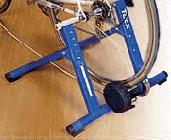Warming up and warming down
Correct warming up and down is as important as the training session itself. Correct warming up not only prepares your muscles for the upcoming efforts but prepares you mentally as well.
A method
If you use a heart monitor, warm up for the first five minutes, during which your pulse rate should gradually increase to high-level 1/low-level 2 (see elsewhere) pedalling a 42/16 gear at about 90 - 100 revs per minutes.
After five minutes, change up a sprocket to 42/15 and maintain your pedal revs at around 100 rpm, this should raise your pulse rate comfortably into level 2 range and you should then be ready for your training session.
Warming down is to gradually bring your body reaction down to normal levels again and also assist the dispersal of any lactic acid build-up. Using a 42/16 gear ratio, pedal at 90 rpm for five minutes, then reduce your pedal revs to about 60 rpm for a further five minutes, or until your pulse rate has reduced into level 1.
The warm up and warm down procedures are essential to turbo sessions and should be performed at every training session.
Criss Cross Sessions
 These sessions are ideal for taking some of the monotony out of early season turbo sessions. They can be used to do aerobic or AT sessions and are particularly useful for completing aerobic sessions on the turbo or on the road.
These sessions are ideal for taking some of the monotony out of early season turbo sessions. They can be used to do aerobic or AT sessions and are particularly useful for completing aerobic sessions on the turbo or on the road.
You need an HRM (For a wide selection of the best heart rate monitors from POLAR, click the name) and a knowledge of your heart rates. If you work aerobically at between 137-147 then set your HRM to 136 for the low limit and 148 for the high (I am assuming your HRM will allow you to set in your limits in this way, some work in multiples of 5).
Having warmed up and reached 137 bpm, gradually increase your effort until your HRM starts beeping at you i.e. you have reached 148 bpm. Slacken off the intensity a little and allow your heart rate to drop back down to 137, then back up etc.
The decreasing intervals workout:
Warm up, select a 52 x 16 gear and pedal at a rate of 100 rpm. During this effort your heart rate should raise into level 4, so don't hold back. On completion of the minute effort, change down to 42 x 16 or 17, keeping your pedal revs at below 90 to allow recovery and your heart rate down to low level 2.
Then change up again to your 52 x 16 gear and go hard for 50 seconds. Recover to low level 2, then hard for 40 seconds ... recover, and repeat doing a hard 30 seconds ... recover, then 20 seconds ... recover, then 10 seconds effort, on completion of this (if you don't fall off the bike) warm down to recovery level.
During these reverse sessions the recovery time will vary depending on your standard of fitness. If your recovery is quick, make sure that it is a genuine fast recovery and not the result of a lack of effort during your work period.
During the work period your pedal revs should be around 100 rpm, if you are unable to maintain revs at 100 rpm you are overgeared, so change down to a smaller gear or increase your effort (if you can). Your pulse rate must be close to your maximum at the end of each interval and subsequently these sessions are hard.
The 5-minute pyramid workout:
There are numerous variations to this training session. I suggest the use of a heart rate monitor, or if you are lucky enough to own a "computerised" turbo, this type of programme can easily be programmed into your unit.
You first decide whether you want it to be an anaerobic, or AT session. Lets say AT for the purpose of this example and lets say your AT is 160 bpm and you want to do a one hour session.
After a 10-minute warm-up, do 5 minutes at 140-145 bpm, then 5 minutes at 145-150 bpm, then 5 minutes at 150-155 and so on until you reach 160-165, then "come down the other side". This gives you 9 x 5 minute interval session and with your warm-up and warm down a session of 65 minutes in total.
It will take several sessions for you to find the level of turbo training that suits you but persevere and train hard and you will soon gain the benefits with improved performances on the road, track or trails.
For a selection of Turbo trainers click the link.